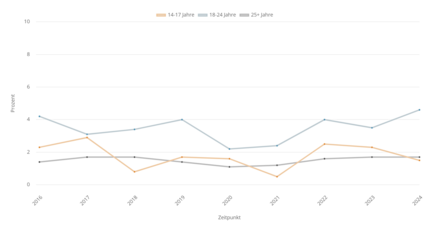
Background information
Vaping instead of smoking: from the frying pan into the fire?
by Patrick Vogt

Launched as a less harmful alternative to cigarettes and a means of giving up smoking, e-cigarettes were almost considered a beacon of hope when they conquered the market 18 years ago. Today, we know that vaping is anything but harmless and doesn’t spare you from serious respiratory diseases.
E-cigarettes, also known as vapes, turned 18 this year. Worldwide distribution started in 2007, and it’s since become as much a part of urban landscapes as takeaway coffees. In 2023, around 2.2 per cent of the German population used e-cigarettes, in Switzerland it was even 4.3 per cent in 2024 (pages in German). Vape shops have popped up on every corner and places previously declared smoke-free are now vape-friendly zones.
Attitudes after the introduction of vapes were positive. They were hailed a healthier option to cigarettes, helpful for giving up nicotine and combatting the spread of serious diseases such as COPD.
The dream of «healthy smoking» was soon shattered. Many consumers consume tobacco and e-cigarettes at the same time. And instead of promoting a decline of smokers, numbers have actually risen again in recent years, according to Professor Daniel Kotz from Düsseldorf University Hospital (video in German). In addition, colourful designs and fruit flavours appeal to young people in particular. So instead of making it easier to stop smoking, e-cigarettes make it easier to start in the first place.


Vapes are available in hundreds of different flavours and with or without nicotine. Unlike cigarettes, vaping doesn’t involve burning tobacco, but vaporising a liquid. Addiction researcher Professor Kotz emphasises that this vapour still contains harmful substances albeit in lower concentrations.
What this vapour does to our bodies has hardly been researched to date. Only a fraction of the more than 10,000 flavourings have been toxicologically tested to date. And since e-cigarettes are still relatively new – even the earliest users have only been vaping for a maximum of 18 years – real long-term studies are still a long way off. However, the current study results already paint a sobering picture:
But there’s good news, too. The lungs have immense self-healing powers. According to the German Federal Ministry of Health, your oxygen supply improves just one to two hours after your last cigarette or e-cigarette. The risk of heart attack decreases after 24 hours of no smoking. After a few weeks, inflammation subsides and coughing and shortness of breath decrease. How well your lungs recover depends on how long you’ve been vaping or smoking. The best thing to do here is to stop as early as possible – or not start in the first place.
If you want to stop smoking, you can find help on these German-language pages:
Freelance writer, biologist and yoga teacher. Fascinated by nature, body and mind, I love spending time outdoors and being active. More than anything, I enjoy writing about things that make us feel good!
Interesting facts about products, behind-the-scenes looks at manufacturers and deep-dives on interesting people.
Show all